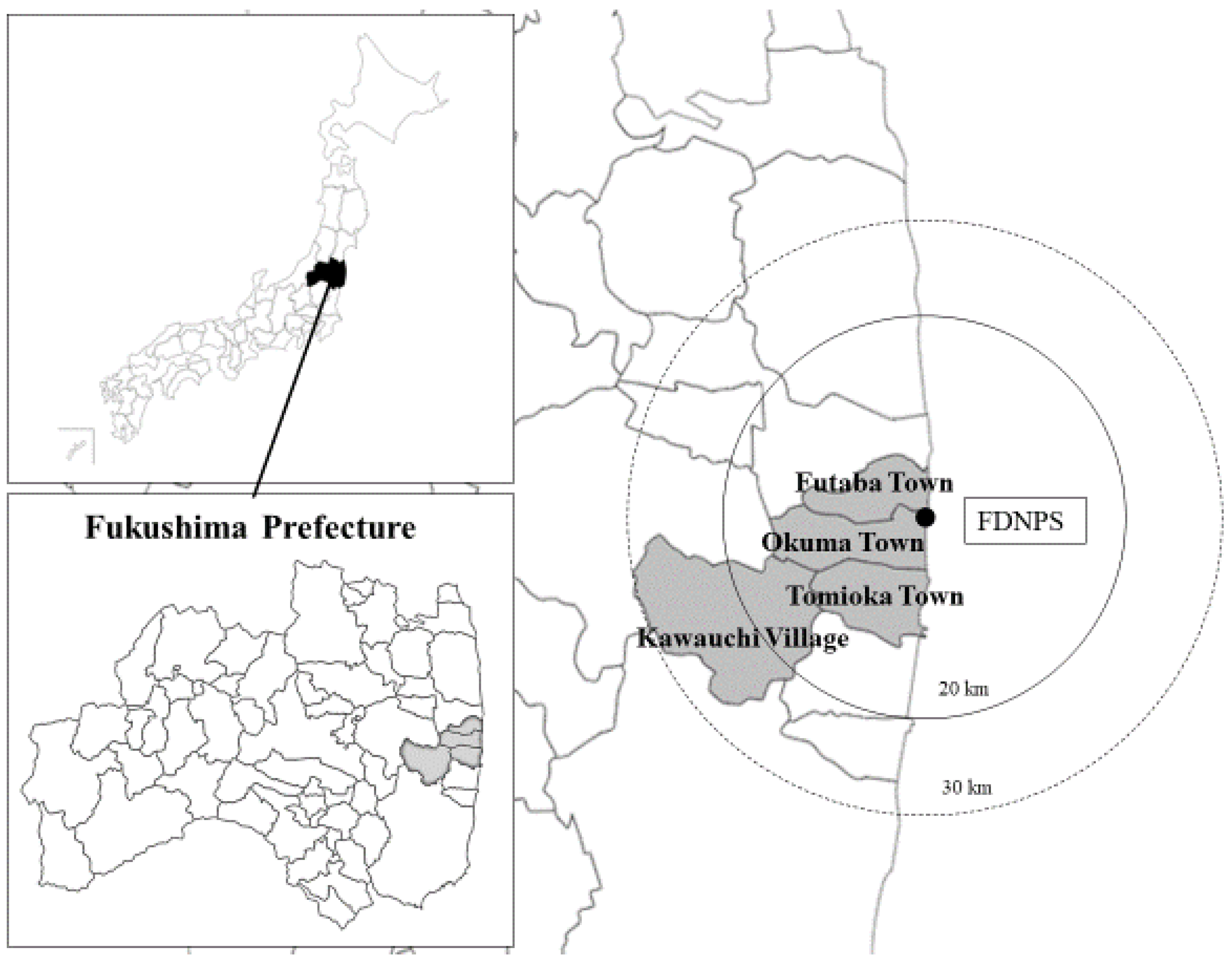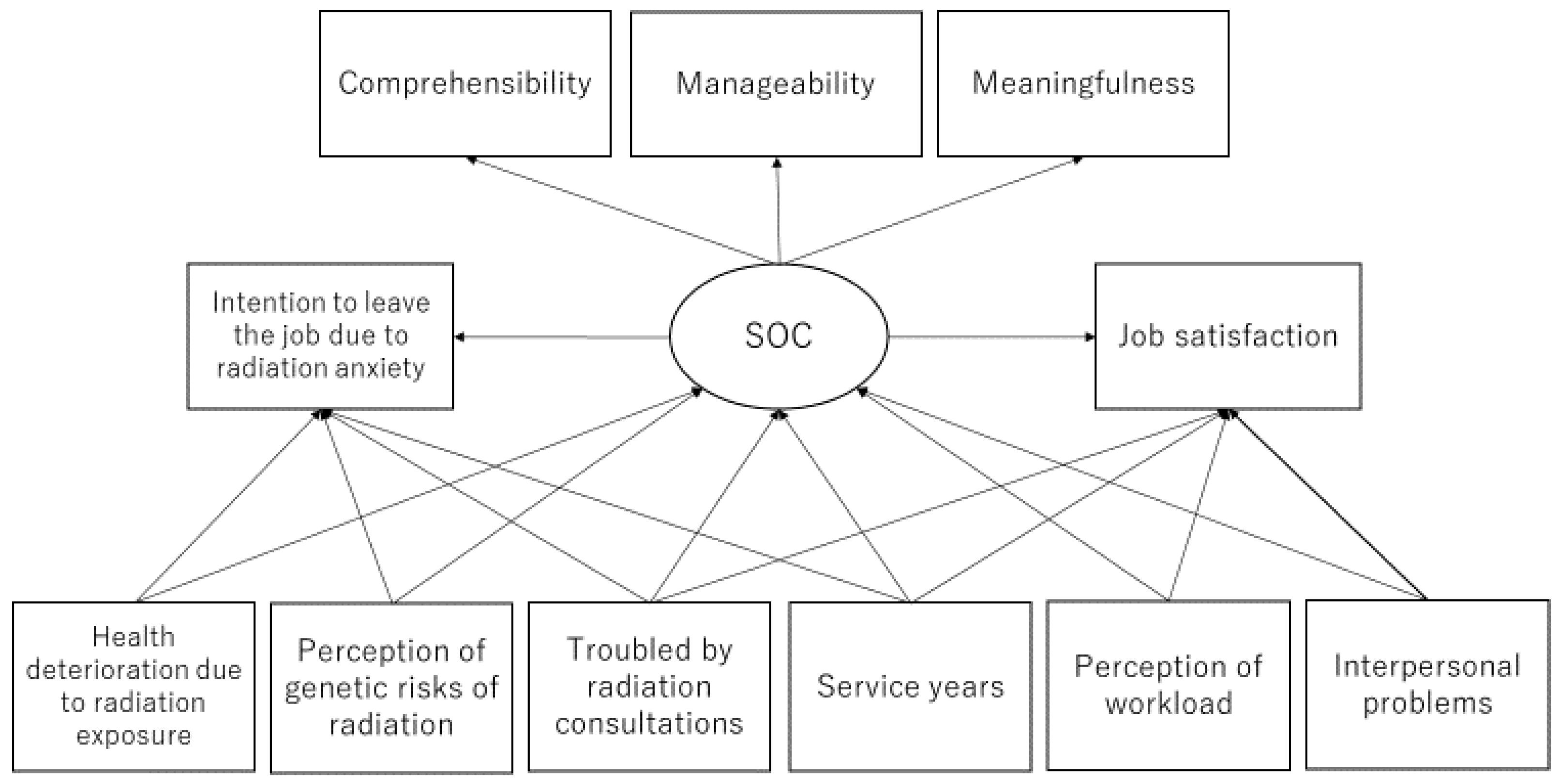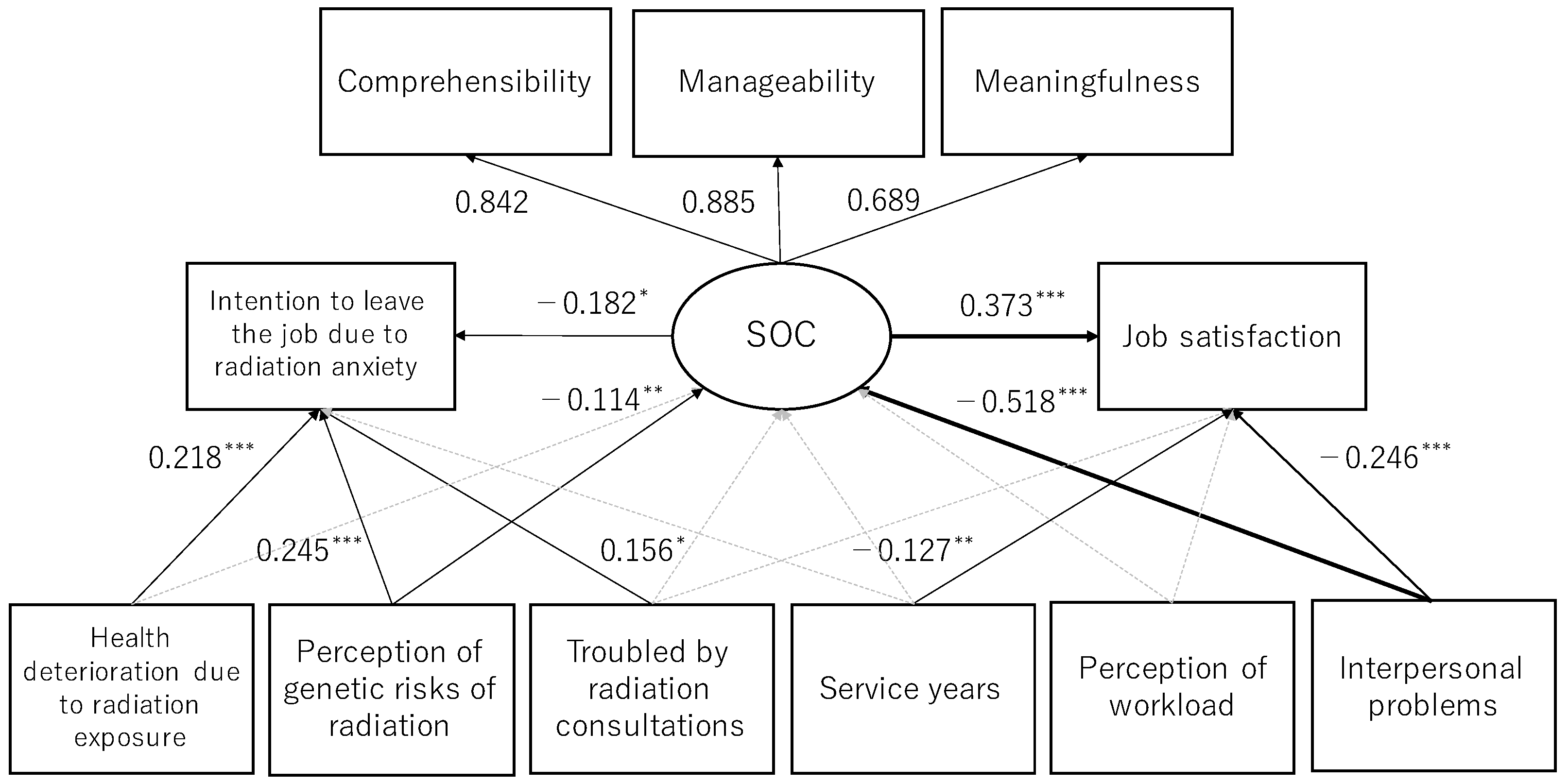Occupational Difficulties of Disaster-Affected Local Government Employees in the Long-Term Recovery Phase after the Fukushima Nuclear Accident: A Cross-Sectional Study Using Modeling Analysis
Abstract
:1. Introduction
2. Materials and Methods
2.1. Study Participants
2.2. Measures
2.3. Statistical Analysis
3. Results
4. Discussion
5. Conclusions
Author Contributions
Funding
Institutional Review Board Statement
Informed Consent Statement
Data Availability Statement
Acknowledgments
Conflicts of Interest
References
- Konno, S.; Hozawa, A.; Munakata, M. Blood pressure among public employees after the Great East Japan Earthquake: The Watari study. Am. J. Hypertens. 2013, 26, 1059–1063. [Google Scholar] [CrossRef] [PubMed] [Green Version]
- Kitamura, H.; Shindo, M.; Tachibana, A.; Honma, H.; Someya, T. Personality and Resilience Associated with Perceived Fatigue of Local Government Employees Responding to Disasters. J. Occup. Health 2013, 55, 1–5. [Google Scholar] [CrossRef] [PubMed] [Green Version]
- Sakuma, A.; Takahashi, Y.; Ueda, I.; Sato, H.; Katsura, M.; Abe, M.; Nagao, A.; Suzuki, Y.; Kakizaki, M.; Tsuji, I.; et al. Post-traumatic stress disorder and depression prevalence and associated risk factors among local disaster relief and reconstruction workers fourteen months after the Great East Japan Earthquake: A cross-sectional study. BMC Psychiatry 2015, 15, 58. [Google Scholar] [CrossRef] [PubMed] [Green Version]
- Bromet, E.J.; Havenaar, J.M.; Guey, L.T. A 25 year retrospective review of the psychological consequences of the Chernobyl accident. Clin. Oncol. (R. Coll. Radiol) 2011, 23, 297–305. [Google Scholar] [CrossRef]
- UNSCEAR. NLevels and Effects of Radiation Exposure due to the Accident at the Fukushima Daiichi Nuclear Power Station: Implications of Information Published Since the UNSCEAR 2013 Reporto Title; UNSCEAR: NewYork, NY, USA, 2020. [Google Scholar]
- Takebayashi, Y.; Lyamzina, Y.; Suzuki, Y.; Murakami, M. Risk Perception and Anxiety Regarding Radiation after the 2011 Fukushima Nuclear Power Plant Accident: A Systematic Qualitative Review. Int. J. Environ. Res. Public Health 2017, 14, 1306. [Google Scholar] [CrossRef] [Green Version]
- Oe, M.; Takebayashi, Y.; Sato, H.; Maeda, M. Mental Health Consequences of the Three Mile Island, Chernobyl, and Fukushima Nuclear Disasters: A Scoping Review. Int. J. Environ. Res. Public Health 2021, 18, 7478. [Google Scholar] [CrossRef]
- World Health Organization. A Framework for Mental Health and Psychosocial Support in Radiological and Nuclear Emergencies; World Health Organization: Genova, Italy, 2020; Licence: CC BY-NC-SA 3.0 IGO. [Google Scholar]
- Maeda, M.; Ueda, Y.; Nagai, M.; Fujii, S.; Oe, M. Diagnostic interview study of the prevalence of depression among public employees engaged in long-term relief work in Fukushima. Psychiatry Clin. Neurosci. 2016, 70, 413–420. [Google Scholar] [CrossRef] [Green Version]
- Murakami, M.; Sato, A.; Matsui, S.; Goto, A.; Kumagai, A.; Tsubokura, M.; Orita, M.; Takamura, N.; Kuroda, Y.; Ochi, S. Communicating with Residents about Risks Following the Fukushima Nuclear Accident. Asia-Pacific J. Public Health 2017, 29, 74S–89S. [Google Scholar] [CrossRef] [Green Version]
- Takamura, N.; Orita, M.; Taira, Y.; Matsunaga, H.; Yamashita, S. Experiences of crisis communication during radiation emergency and risk communication for recovery of the community in Fukushima. J. Radiat. Res. 2021, 62, i95–i100. [Google Scholar] [CrossRef]
- Schneider, T.; Maître, M.; Lochard, J.; Charron, S.; Lecomte, J.F.; Ando, R.; Kanai, Y.; Kurihara, M.; Kuroda, Y.; Miyazaki, M.; et al. The role of radiological protection experts in stakeholder involvement in the recovery phase of post-nuclear accident situations: Some lessons from the Fukushima-Daïchi NPP accident. Radioprotection 2019, 54, 259–270. [Google Scholar] [CrossRef] [Green Version]
- Antonovsky, A. Unraveling the Mystery of Health: How People Manage Stress and Stay Well [Kenko-no-nazo-wo-toku]; Trans Yamazaki, Y., Yoshii, K., Eds.; Yushindo Kobunsha: Tokyo, Japan, 1987. (In Japanese) [Google Scholar]
- Eriksson, M.; Lindström, B. Antonovsky’s sense of coherence scale and the relation with health: A systematic review. J. Epidemiol. Community Health 2006, 60, 376–381. [Google Scholar] [CrossRef] [PubMed]
- Immediate Report on the Damage Caused by the 2011 of the Pacific Coast of Tohoku Earthquakele. Available online: https://www.pref.fukushima.lg.jp/site/portal/shinsai-higaijokyo.html (accessed on 26 January 2022).
- Clark, A.E.; Oswald, A.J. Satisfaction and comparison income. J. Public Econ. 1996, 61, 359–381. [Google Scholar] [CrossRef] [Green Version]
- Eriksson, M.; Lindström, B. Validity of Antonovsky’s sense of coherence scale: A systematic review. J. Epidemiol. Community Health 2005, 59, 460–466. [Google Scholar] [CrossRef] [PubMed]
- Antonovsky, A. The structure and properties of the sense of coherence scale. Soc. Sci. Med. 1993, 36, 725–733. [Google Scholar] [CrossRef]
- Li, C.H. Confirmatory factor analysis with ordinal data: Comparing robust maximum likelihood and diagonally weighted least squares. Behav. Res. Methods 2016, 48, 936–949. [Google Scholar] [CrossRef] [Green Version]
- Li, C.H. The performance of ML, DWLS, and ULS estimation with robust corrections in structural equation models with ordinal variables. Psychol. Methods 2016, 21, 369–387. [Google Scholar] [CrossRef]
- Hu, L.; Bentler, P.M. Cutoff criteria for fit indexes in covariance structure analysis: Conventional criteria versus new alternatives. Struct. Equ. Model. A Multidiscip. J. 1999, 6, 1–55. [Google Scholar] [CrossRef]
- Togari, T.; Yamazaki, Y.; Nakayama, K.; Yokoyama, Y.; Yonekura, Y.; Takeuchi, T. Nationally representative score of the Japanese language version of the 13-item 7-point sense of coherence scale. Jpn. J. Public Health 2015, 62, 232–237. (In Japanese) [Google Scholar] [CrossRef]
- Perry, J.L.; Wise, L.R. The Motivational Bases of Public Service. Public Adm. Rev. 1990, 50, 367. [Google Scholar] [CrossRef]
- Wang, T.M.; van Witteloostuijn, A.; Heine, F. A Moral Theory of Public Service Motivation. Front. Psychol. 2020, 11, 517763. [Google Scholar] [CrossRef]
- Orita, M.; Taira, Y.; Matsunaga, H.; Maeda, M.; Takamura, N. Quality of Life and Intention to Return among Former Residents of Tomioka Town, Fukushima Prefecture 9 Years after the Fukushima Daiichi Nuclear Accident. Int. J. Environ. Res. Public Health 2020, 17, 6625. [Google Scholar] [CrossRef] [PubMed]
- Matsunaga, H.; Orita, M.; Liu, M.; Kashiwazaki, Y.; Taira, Y.; Takamura, N. Evaluation of Residents’ Timing of Return to or New Settlement in Kawauchi Village, at 10 Years after the Fukushima Daiichi Nuclear Power Plant Accident. Int. J. Environ. Res. Public Health 2022, 19, 543. [Google Scholar] [CrossRef] [PubMed]
- Cabinet Office Gavernment of Japan. Annual Report on the Japanese Economy and Public Finance 2012; Cabinet Office Gavernment of Japan: Tokyo, Japan, 2012.
- Shirai, K.; Yoshizawa, N.; Takebayashi, Y.; Murakami, M. Modeling reconstruction-related behavior and evaluation of influences of major information sources. PLoS ONE 2019, 14, e0221561, In Japanese. [Google Scholar] [CrossRef] [PubMed] [Green Version]
- Kashiwazaki, Y.; Takebayashi, Y.; Murakami, M. The relationship between geographical region and perceptions of radiation risk after the Fukushima accident: The mediational role of knowledge. Radioprotection 2022, 57, 17–25. [Google Scholar] [CrossRef]
- Langeland, E.; Riise, T.; Hanestad, B.R.; Nortvedt, M.W.; Kristoffersen, K.; Wahl, A.K. The effect of salutogenic treatment principles on coping with mental health problems A randomised controlled trial. Patient Educ. Couns. 2006, 62, 212–219. [Google Scholar] [CrossRef]
- Foureur, M.; Besley, K.; Burton, G.; Yu, N.; Crisp, J. Enhancing the resilience of nurses and midwives: Pilot of a mindfulness-based program for increased health, sense of coherence and decreased depression, anxiety and stress. Contemp. Nurse 2013, 45, 114–125. [Google Scholar] [CrossRef]
- Omura, M.; Maguire, J.; Levett-Jones, T.; Stone, T.E. The effectiveness of assertiveness communication training programs for healthcare professionals and students: A systematic review. Int. J. Nurs. Stud. 2017, 76, 120–128. [Google Scholar] [CrossRef]
- Berkowitz, S.; Bryant, R.; Brymer, M.; Hamblen, J.; Jacobs, A.; Layne, C.; Watson, P. Skills for Psychological Recovery: Field Operations Guide—PTSD: National Center for PTSD. Available online: https://www.ptsd.va.gov/professional/treat/type/skills_psych_recovery_manual.asp (accessed on 24 January 2022).
- Eriksson, M.; Lindström, B. Antonovsky’s sense of coherence scale and its relation with quality of life: A systematic review. J. Epidemiol. Community Health 2007, 61, 938–944. [Google Scholar] [CrossRef] [Green Version]
- Schäfer, S.K.; Becker, N.; King, L.; Horsch, A.; Michael, T. The relationship between sense of coherence and post-traumatic stress: A meta-analysis. Eur. J. Psychotraumatol 2019, 10. [Google Scholar] [CrossRef] [Green Version]
- Kashiwazaki, Y.; Takebayashi, Y.; Murakami, M. Relationships between radiation risk perception and health anxiety, and contribution of mindfulness to alleviating psychological distress after the Fukushima accident: Cross-sectional study using a path model. PLoS ONE 2020, 15, e0235517. [Google Scholar] [CrossRef]
- Slovic, P. Perception of risk. Science 1987, 236, 280–285. [Google Scholar] [CrossRef] [PubMed]



| Overall | Kawauchi | Tomioka | Okuma | Futaba | p | ||||||
|---|---|---|---|---|---|---|---|---|---|---|---|
| n | % | n | % | n | % | n | % | n | % | ||
| Sex | |||||||||||
| Male | 331 | 67.6 | 34 | 75.6 | 104 | 66.7 | 108 | 66.7 | 85 | 66.9 | 0.69 |
| Female | 159 | 32.4 | 11 | 24.4 | 52 | 33.3 | 54 | 33.3 | 42 | 33.1 | |
| Age | |||||||||||
| <40 years old | 195 | 39.8 | 15 | 33.3 | 75 | 48.1 | 57 | 35.2 | 48 | 37.4 | 0.08 |
| ≥40 years old | 295 | 60.2 | 30 | 66.7 | 81 | 51.9 | 105 | 64.8 | 79 | 62.2 | |
| Job satisfaction | |||||||||||
| Satisfied | 353 | 72 | 37 | 82.2 | 111 | 71.2 | 120 | 74.1 | 85 | 66.9 | 0.22 |
| Not satisfied | 137 | 28 | 8 | 17.8 | 45 | 28.8 | 42 | 25.9 | 42 | 33.1 | |
| Intention to leave the job due to radiation anxiety | |||||||||||
| Yes | 44 | 9 | 5 | 11.1 | 18 | 11.5 | 13 | 8 | 8 | 6.3 | 0.42 |
| No | 446 | 91 | 40 | 88.9 | 138 | 88.5 | 149 | 91 | 119 | 93.7 | |
| SOC † | |||||||||||
| mean/SD | 55.6 | 13.2 | 60.6 | 13.9 | 53.6 | 13 | 55.9 | 11.4 | 55.9 | 14.8 | 0.68 |
| Overall (n = 490) | Job Satisfaction | Intention to Leave Work Due to Radiation Anxiety | ||||||||
|---|---|---|---|---|---|---|---|---|---|---|
| Satisfied (n = 353) | Not Satisfied (n = 137) | Yes (n = 44) | No (n = 446) | |||||||
| n | % | n | % | n | % | n | % | n | % | |
| Sex | ||||||||||
| Male | 331 | 67.6 | 237 | 71.6 | 94 | 28.4 | 27 | 8.2 | 304 | 91.8 |
| Female | 159 | 32.4 | 116 | 73 | 43 | 27 | 17 | 10.7 | 142 | 89.3 |
| Age | ||||||||||
| <40 years old | 195 | 39.8 | 141 | 72.3 | 54 | 27.7 | 20 | 10.3 | 175 | 89.7 |
| ≥40 years old | 295 | 60.2 | 212 | 71.9 | 83 | 28.1 | 24 | 8.1 | 271 | 91.9 |
| Service years | ||||||||||
| <10 years | 305 | 62.2 | 241 | 79 | 64 | 21 *** | 13 | 4.3 | 292 | 95.7 *** |
| ≥10 years | 185 | 37.8 | 112 | 60.5 | 73 | 39.5 | 31 | 16.8 | 154 | 83.2 |
| Job satisfaction | ||||||||||
| Satisfied | 353 | 72 | - | - | - | - | 17 | 4.8 | 336 | 95.2 *** |
| Not satisfied | 137 | 28 | - | - | - | - | 27 | 19.7 | 110 | 80.3 |
| Perception of workload | ||||||||||
| Much | 296 | 60.4 | 203 | 68.6 | 93 | 31.4 * | 33 | 11.1 | 263 | 88.9 |
| Not much | 194 | 39.6 | 150 | 77.3 | 44 | 22.7 | 11 | 5.7 | 183 | 94.3 |
| Interpersonal problems | ||||||||||
| Yes | 281 | 57.3 | 165 | 58.7 | 116 | 41.3 *** | 39 | 13.9 | 242 | 86.1 *** |
| No | 209 | 42.7 | 188 | 90 | 21 | 10 | 5 | 2.4 | 204 | 97.6 |
| Troubled by radiation consultations | ||||||||||
| Yes | 134 | 27.3 | 87 | 64.9 | 47 | 35.1 * | 25 | 18.7 | 109 | 81.3 *** |
| No | 356 | 72.7 | 266 | 74.7 | 90 | 25.3 | 19 | 5.3 | 337 | 94.7 |
| Intention to leave the job due to radiation anxiety | ||||||||||
| Yes | 44 | 9 | 17 | 38.6 | 27 | 61.4 *** | - | - | - | - |
| No | 446 | 91 | 336 | 75.3 | 110 | 24.7 | - | - | - | - |
| Health deterioration due to radiation exposure | ||||||||||
| Yes | 29 | 5.9 | 20 | 69 | 9 | 31 | 14 | 48.3 | 15 | 51.7 *** |
| No | 461 | 94.1 | 333 | 72.2 | 128 | 27.8 | 30 | 6.5 | 431 | 93.5 |
| Perception of risk of genetic effects of radiation | ||||||||||
| Yes | 148 | 30.2 | 99 | 66.9 | 49 | 33.1 | 28 | 18.9 | 120 | 81.1 *** |
| No | 342 | 69.8 | 254 | 74.3 | 88 | 25.7 | 16 | 4.7 | 326 | 95.3 |
| SOC † | mean | SD | mean | SD | mean | SD | mean | SD | mean | SD |
| 55.6 | 13.2 | 59 | 11.8 | 47 | 12.8 *** | 46.7 | 13.6 | 56.5 | 12.8 *** | |
Publisher’s Note: MDPI stays neutral with regard to jurisdictional claims in published maps and institutional affiliations. |
© 2022 by the authors. Licensee MDPI, Basel, Switzerland. This article is an open access article distributed under the terms and conditions of the Creative Commons Attribution (CC BY) license (https://creativecommons.org/licenses/by/4.0/).
Share and Cite
Kashiwazaki, Y.; Matsunaga, H.; Orita, M.; Taira, Y.; Oishi, K.; Takamura, N. Occupational Difficulties of Disaster-Affected Local Government Employees in the Long-Term Recovery Phase after the Fukushima Nuclear Accident: A Cross-Sectional Study Using Modeling Analysis. Int. J. Environ. Res. Public Health 2022, 19, 3979. https://doi.org/10.3390/ijerph19073979
Kashiwazaki Y, Matsunaga H, Orita M, Taira Y, Oishi K, Takamura N. Occupational Difficulties of Disaster-Affected Local Government Employees in the Long-Term Recovery Phase after the Fukushima Nuclear Accident: A Cross-Sectional Study Using Modeling Analysis. International Journal of Environmental Research and Public Health. 2022; 19(7):3979. https://doi.org/10.3390/ijerph19073979
Chicago/Turabian StyleKashiwazaki, Yuya, Hitomi Matsunaga, Makiko Orita, Yasuyuki Taira, Keiko Oishi, and Noboru Takamura. 2022. "Occupational Difficulties of Disaster-Affected Local Government Employees in the Long-Term Recovery Phase after the Fukushima Nuclear Accident: A Cross-Sectional Study Using Modeling Analysis" International Journal of Environmental Research and Public Health 19, no. 7: 3979. https://doi.org/10.3390/ijerph19073979
APA StyleKashiwazaki, Y., Matsunaga, H., Orita, M., Taira, Y., Oishi, K., & Takamura, N. (2022). Occupational Difficulties of Disaster-Affected Local Government Employees in the Long-Term Recovery Phase after the Fukushima Nuclear Accident: A Cross-Sectional Study Using Modeling Analysis. International Journal of Environmental Research and Public Health, 19(7), 3979. https://doi.org/10.3390/ijerph19073979






